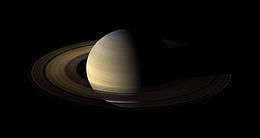Equinox
| UT date and time of equinoxes and solstices on Earth[1] | ||||||||
|---|---|---|---|---|---|---|---|---|
| event | equinox | solstice | equinox | solstice | ||||
| month | March | June | September | December | ||||
| year | ||||||||
| day | time | day | time | day | time | day | time | |
| 2010 | 20 | 17:32 | 21 | 11:28 | 23 | 03:09 | 21 | 23:38 |
| 2011 | 20 | 23:21 | 21 | 17:16 | 23 | 09:04 | 22 | 05:30 |
| 2012 | 20 | 05:14 | 20 | 23:09 | 22 | 14:49 | 21 | 11:12 |
| 2013 | 20 | 11:02 | 21 | 05:04 | 22 | 20:44 | 21 | 17:11 |
| 2014 | 20 | 16:57 | 21 | 10:51 | 23 | 02:29 | 21 | 23:03 |
| 2015 | 20 | 22:45 | 21 | 16:38 | 23 | 08:21 | 22 | 04:48 |
| 2016 | 20 | 04:30 | 20 | 22:34 | 22 | 14:21 | 21 | 10:44 |
| 2017 | 20 | 10:28 | 21 | 04:24 | 22 | 20:02 | 21 | 16:28 |
| 2018 | 20 | 16:15 | 21 | 10:07 | 23 | 01:54 | 21 | 22:23 |
| 2019 | 20 | 21:58 | 21 | 15:54 | 23 | 07:50 | 22 | 04:19 |
| 2020 | 20 | 03:50 | 20 | 21:44 | 22 | 13:31 | 21 | 10:02 |
An equinox is an astronomical event in which the plane of Earth's equator passes through the center of the Sun,[2] which occurs twice each year, around 20 March and 23 September.
On an equinox, day and night are of approximately equal duration all over the planet. They are not exactly equal, however, due to the angular size of the sun and atmospheric refraction. To avoid this ambiguity, the word equilux is sometimes used to mean a day in which the durations of light and darkness are equal.[3][note 1] See Length of equinoctial day and night for further discussion.
The word is derived from the Latin aequinoctium, aequus (equal) and nox (genitive noctis) (night).
Equinoxes on Earth
General
The equinoxes are the only times when the solar terminator (the "edge" between night and day) is perpendicular to the equator. As a result, the northern and southern hemispheres are equally illuminated. The word comes from Latin equi or "equal" and nox meaning "night".
In other words, the equinoxes are the only times when the subsolar point is on the equator, meaning that the Sun is exactly overhead at a point on the equatorial line. The subsolar point crosses the equator moving northward at the March equinox and southward at the September equinox.
The equinoxes, along with solstices, are directly related to the seasons of the year. In the northern hemisphere, the vernal equinox (March) conventionally marks the beginning of spring in most cultures and is considered the New Year in the Persian calendar or Iranian calendars as Nouroz (means new day), while the autumnal equinox (September) marks the beginning of autumn. In the southern hemisphere, the vernal equinox occurs in September and the autumnal equinox in March.


 Diagram of the Earth's seasons as seen from the north. Far right: December solstice.
Diagram of the Earth's seasons as seen from the north. Far right: December solstice. Diagram of the Earth's seasons as seen from the south. Far left: June solstice.
Diagram of the Earth's seasons as seen from the south. Far left: June solstice.
Date
When Julius Caesar established the Julian calendar in 45 BC, he set 25 March as the date of the spring equinox. Because the Julian year (365.25 days) is slightly longer than the tropical year, the calendar "drifted" with respect to the two equinoxes — such that in 300 AD the spring equinox occurred on about 21 March. By 1500 AD, it had drifted backwards to 11 March.
This drift induced Pope Gregory XIII to create a modern Gregorian calendar. The Pope wanted to continue to conform with the edicts concerning the date of Easter of the Council of Nicaea of AD 325, which means he wanted to move the vernal equinox to 21 March, which is the day allocated to it in the Easter table of the Julian calendar. However, the leap year intervals in his calendar were not smooth (400 is not an exact multiple of 97). This causes the equinox to oscillate by about 53 hours around its mean position. This in turn raised the possibility that it could fall on 22 March, and thus Easter Day might theoretically commence before the equinox. The astronomers chose the appropriate number of days to omit so that the equinox would swing from 19 to 21 March but never fall on the 22nd (although it can in a handful of years fall early in the morning of that day in the Far East).
Names
- Spring equinox and fall (or autumn) equinox: colloquial names based on the seasons. However, these can be ambiguous since the northern hemisphere's spring is the southern hemisphere's autumn, and vice versa. The Latinate names vernal equinox (spring) and autumnal equinox (fall) are often used to the same effect.
- March equinox and September equinox: names referring to the months of the year they occur, with no ambiguity as to which hemisphere is the context. They are still not universal, however, as not all cultures use a solar-based calendar where the equinoxes occur every year in the same month (as they do not in the Islamic calendar and Hebrew calendar, for example).
- Northward equinox and southward equinox: names referring to the apparent direction of motion of the Sun. The northward equinox occurs in March when the sun crosses the equator from south to north, and the southward equinox occurs in September when the sun crosses the equator from north to south. These terms can be used unambiguously for other planets.
- First Point of Aries and first point of Libra: names referring to the astrological signs the sun is entering. Due to the precession of the equinoxes, however, the constellations where the equinoxes are currently located are Pisces and Virgo, respectively.
Length of equinoctial day and night

Day is usually defined as the period when sunlight reaches the ground in the absence of local obstacles. On the day of the equinox, the center of the Sun spends a roughly equal amount of time above and below the horizon at every location on the Earth, so night and day are about the same length. In reality, the day is longer than the night at an equinox. There are two reasons for this:[2]
First, from the Earth, the Sun appears as a disc rather than a point of light, so when the centre of the Sun is below the horizon, its upper edge is visible. Sunrise, which begins daytime, occurs when the top of the Sun's disk rises above the eastern horizon. At that instant, the disk's centre is still below the horizon.
Second, Earth's atmosphere refracts sunlight. As a result, an observer sees daylight before the top of the Sun's disk rises above the horizon. Even when the upper limb of the Sun is 0.4 degrees below the horizon, its rays curve over the horizon to the ground.
In sunrise/sunset tables, the assumed semidiameter (apparent radius) of the Sun is 16 minutes of arc and the atmospheric refraction is assumed to be 34 minutes of arc. Their combination means that when the upper limb of the Sun is on the visible horizon, its centre is 50 minutes of arc below the geometric horizon, which is the intersection with the celestial sphere of a horizontal plane through the eye of the observer. These effects make the day about 14 minutes longer than the night at the equator and longer still towards the poles. The real equality of day and night only happens in places far enough from the equator to have a seasonal difference in day length of at least 7 minutes, actually occurring a few days towards the winter side of each equinox.
The times of sunset and sunrise vary with the observer's location (longitude and latitude), so the dates when day and night are equal also depend upon the observer's location.
At the equinoxes, the rate of change for the length of daylight and night-time is the greatest. At the poles, the equinox marks the transition from 24 hours of nighttime to 24 hours of daylight (or vice versa).
Geocentric view of the astronomical seasons
In the half-year centered on the June solstice, the Sun rises north of east and sets north of west, which means longer days with shorter nights for the northern hemisphere and shorter days with longer nights for the southern hemisphere. In the half-year centered on the December solstice, the Sun rises south of east and sets south of west and the durations of day and night are reversed.
Also on the day of an equinox, the Sun rises everywhere on Earth (except at the poles) at about 06:00 and sets at about 18:00 (local solar time). These times are not exact for several reasons:
- The Sun is much larger in diameter than the Earth, so that more than half of the Earth could be in sunlight at any one time (due to unparallel rays creating tangent points beyond an equal-day-night line).
- Most places on Earth use a time zone which differs from the local solar time by minutes or even hours. For example, if a location uses a time zone with reference meridian 15° to the East, the Sun will rise around 07:00 on the equinox and set 12 hours later around 19:00.
- Day length is also affected by the variable orbital speed of the Earth around the sun. This combined effect is described as the equation of time. Thus even locations which lie on their time zone's reference meridian will not see sunrise and sunset at 6:00 and 18:00. At the March equinox they are 7–8 minutes later, and at the September equinox they are about 7–8 minutes earlier.
- Sunrise and sunset are commonly defined for the upper limb of the solar disk, rather than its center. The upper limb is already up for at least a minute before the center appears, and the upper limb likewise sets later than the center of the solar disk. Also, when the Sun is near the horizon, atmospheric refraction shifts its apparent position above its true position by a little more than its own diameter. This makes sunrise more than two minutes earlier and sunset an equal amount later. These two effects combine to make the equinox day 12 h 7 min long and the night only 11 h 53 min. Note, however, that these numbers are only true for the tropics. For moderate latitudes, the discrepancy increases (e.g., 12 minutes in London); and closer to the poles it becomes very much larger (in terms of time). Up to about 100 km from either pole, the Sun is up for a full 24 hours on an equinox day.
- Night includes twilight. If dawn and dusk are instead considered daytime, the day would be almost 13 hours near the equator, and longer at higher latitudes.
- Height of the horizon changes the day's length. For an observer atop a mountain the day is longer, while standing in a valley will shorten the day.
Day arcs of the Sun
Some of the statements above can be made clearer by picturing the day arc (i.e., the path the Sun tracks along the celestial dome in its diurnal movement). The pictures show this for every hour on equinox day. In addition, some 'ghost' suns are also indicated below the horizon, up to 18° below it; the Sun in such areas still causes twilight. The depictions presented below can be used for both the northern hemisphere and the southern hemisphere. The observer is understood to be sitting near the tree on the island depicted in the middle of the ocean; the green arrows give cardinal directions.
- In the northern hemisphere, north is to the left, the Sun rises in the east (far arrow), culminates in the south (right arrow), while moving to the right and setting in the west (near arrow).
- In the southern hemisphere, south is to the left, the Sun rises in the east (near arrow), culminates in the north (right arrow), while moving to the left and setting in the west (far arrow).
The following special cases are depicted:
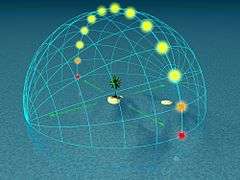 Day arc at 0° latitude (equator)
Day arc at 0° latitude (equator)
The arc passes through the zenith, resulting in almost no shadows at high noon.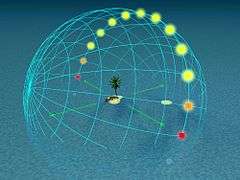 Day arc at 20° latitude
Day arc at 20° latitude
The Sun culminates at 70° altitude and its path at sunrise and sunset occurs at a steep 70° angle to the horizon. Twilight still lasts about one hour.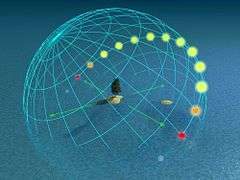 Day arc at 50° latitude
Day arc at 50° latitude
Twilight lasts almost two hours.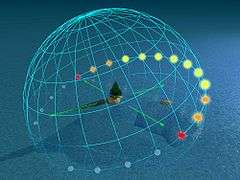 Day arc at 70° latitude
Day arc at 70° latitude
The Sun culminates at no more than 20° altitude and its daily path at sunrise and sunset is at a shallow 20° angle to the horizon. Twilight lasts for more than four hours; in fact, there is barely any night. Day arc at 90° latitude (pole)
Day arc at 90° latitude (pole)
If it were not for atmospheric refraction, the Sun would be on the horizon all the time.
Celestial coordinate systems
The vernal equinox occurs in March, about when the Sun crosses the celestial equator south to north. The term "vernal point" is used for the time of this occurrence and for the direction in space where the Sun is seen at that time, which is the origin of some celestial coordinate systems:
- in the ecliptic coordinate system, the vernal point is the origin of the ecliptic longitude;
- in the equatorial coordinate system, the vernal point is the origin of the right ascension.
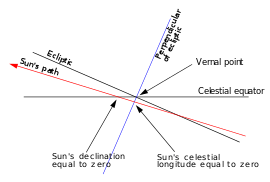
Strictly speaking, at the equinox the Sun's ecliptic longitude is zero. Its latitude will not be exactly zero since the Earth is not exactly in the plane of the ecliptic. Its declination will not be exactly zero either. (The ecliptic is defined by the center of mass of the Earth and Moon combined.) The modern definition of equinox is the instants when the Sun's apparent geocentric longitude is 0° (northward equinox) or 180° (southward equinox).[4][5][6] See the adjacent diagram.
Because of the precession of the Earth's axis, the position of the vernal point on the celestial sphere changes over time, and the equatorial and the ecliptic coordinate systems change accordingly. Thus when specifying celestial coordinates for an object, one has to specify at what time the vernal point and the celestial equator are taken. That reference time is called the equinox of date.[7]
The autumnal equinox is at ecliptic longitude 180° and at right ascension 12h.
The upper culmination of the vernal point is considered the start of the sidereal day for the observer. The hour angle of the vernal point is, by definition, the observer's sidereal time.
Using the current official IAU constellation boundaries – and taking into account the variable precession speed and the rotation of the celestial equator – the equinoxes shift through the constellations as follows[8] (expressed in astronomical year numbering in which the year 0 = 1 BC, −1 = 2 BC, etc.):
- The March equinox passed from Taurus into Aries in year −1865, passed into Pisces in year −67, will pass into Aquarius in year 2597, will pass into Capricornus in year 4312. It passed along (but not into) a 'corner' of Cetus on 0°10' distance in year 1489.
- The September equinox passed from Libra into Virgo in year −729, will pass into Leo in year 2439.
Cultural aspects
The equinoxes are sometimes regarded as the start of spring and autumn. A number of traditional (harvest) festivals are celebrated on the date of the equinoxes.
Equinoxes on other planets
Equinox is a phenomenon that can occur on any planet with a significant tilt to its rotational axis. Most dramatic of these is Saturn, where the equinox places its ring system edge-on facing the Sun. As a result, they are visible only as a thin line when seen from Earth. When seen from above – a view seen by humans during an equinox for the first time from the Cassini space probe in 2009 – they receive very little sunshine, indeed more planetshine than light from the Sun.[9]
This lack of sunshine occurs once every 14.7 years. It can last a few weeks before and after the exact equinox. The most recent exact equinox for Saturn was on 11 August 2009. Its next equinox will take place on 30 April 2024.
One effect of equinoctial periods is the temporary disruption of communications satellites. For all geostationary satellites, there are a few days around the equinox when the sun goes directly behind the satellite relative to Earth (i.e. within the beam-width of the ground-station antenna) for a short period each day. The Sun's immense power and broad radiation spectrum overload the Earth station's reception circuits with noise and, depending on antenna size and other factors, temporarily disrupt or degrade the circuit. The duration of those effects varies but can range from a few minutes to an hour. (For a given frequency band, a larger antenna has a narrower beam-width and hence experiences shorter duration "Sun outage" windows.)
See also
- Anjana (Cantabrian mythology), fairies believed to appear on the spring equinox
- Aphelion – occurs around 5 July (see formula)
- Lady Day
- Nowruz
- Solstice
- Songkran (disambiguation)
- Sun outage – a phenomenon that occurs around the time of an equinox
Notes
- ↑ This meaning of "equilux" is rather modern (c. 2006) and unusual. Technical references since the beginning of the 20th century (c. 1910) use the terms "equilux" and "isophot" to mean "of equal illumination" in the context of curves showing how intensely lighting equipment will illuminate a surface. See for instance John William Tudor Walsh, Textbook of Illuminating Engineering (Intermediate Grade), I. Pitman, 1947.
References
- ↑ United States Naval Observatory (2015-09-21). "Earth's Seasons: Equinoxes, Solstices, Perihelion, and Aphelion, 2000-2025". Retrieved 2015-12-09.
- 1 2 "Equinoxes". USNO Astronomical Information Center FAQ. Retrieved 4 September 2015.
- ↑ Owens, Steve (20 March 2010). "Equinox, Equilux, and Twilight Times". Dark Sky Diary (blog). Retrieved 31 December 2010.
- ↑ Meeus, Jean (1997). Mathematical Astronomy Morsels.
- ↑ United States Naval Observatory (2006). Astronomical Almanac 2008. Glossary Chapter
- ↑ Meeus, Jean (1998). Astronomical Algorithms, Second Edition.
- ↑ Montenbruck, Oliver; Pfleger, Thomas. Astronomy on the Personal Computer. Springer-Verlag. p. 17. ISBN 0-387-57700-9.
- ↑ J. Meeus; Mathematical Astronomical Morsels; ISBN 0-943396-51-4
- ↑ "PIA11667: The Rite of Spring". Jet Propulsion Laboratory, California Institute of Technology. Retrieved 21 March 2014.
External links
| Wikiquote has quotations related to: Equinox |
| Wikimedia Commons has media related to Equinox. |
- Day and Night World Map (night and day map on equinox)
- Calculation of Length of Day (Formulas and Graphs)
- Equinoctial Points – The Nuttall Encyclopædia
- Table of times for Equinoxes, Solstices, Perihelion and Aphelion in 2000–2020
- Table of times of Spring Equinox for a thousand years: 1452–2547
- Gray, Meghan; Merrifield, Michael. "Solstice and Equinox". Sixty Symbols. Brady Haran for the University of Nottingham.
